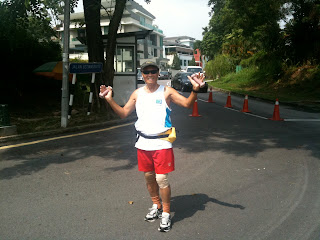One of the most
important and vital understanding of cancer growth mechanism is Angiogenesis.
It is this very mechanism that the body feeds cancer cells which invariably
causes Metastasis; allowing cancer cells to spread to other parts of the body.
Thanks to The Angiogenesis Foundation that more studies and researches are
being undertaken to mitigate and arrest Metastasis. If we want to fight off
Metastasis we should first understand the underlining factors in Angiogenesis.
Below are extracts from
the Foundation.
1. How the body controls Angiogenesis
Angiogenesis
(angio'gen'esis) -- the growth of new blood
vessels -- is an important natural process occurring in the body, both in
health and in disease.
Angiogenesis occurs in the healthy body for healing
wounds and for restoring blood flow to tissues after injury or insult. In
females, angiogenesis also occurs during the monthly reproductive cycle (to
rebuild the uterus lining, to mature the egg during ovulation) and during
pregnancy (to build the placenta, the circulation between mother and fetus).
The healthy body controls
angiogenesis through a series of "on" and "off" switches:
The
main "on" switches are known as angiogenesis-stimulating growth factors
The
main "off switches" are known as angiogenesis inhibitors
When angiogenic growth
factors are produced in excess of angiogenesis inhibitors, the balance is
tipped in favor of blood vessel growth. When inhibitors are present in excess
of stimulators, angiogenesis is stopped. The normal, healthy body maintains a
perfect balance of angiogenesis modulators. In general, angiogenesis is
"turned off" by the production of more inhibitors than stimulators.
2. The Angiogenesis Process:
How Do New Blood Vessels Grow?
The process of
angiogenesis occurs as an orderly series of events:
Diseased
or injured tissues produce and release angiogenic growth factors (proteins)
that diffuse into the nearby tissues.
The
angiogenic growth factors bind to specific receptors located on the endothelial
cells (EC) of nearby preexisting blood vessels.
Once
growth factors bind to their receptors, the endothelial cells become activated.
Signals are sent from the cell's surface to the nucleus.
The
endothelial cell's machinery begins to produce new molecules including enzymes.
These enzymes dissolve tiny holes in the sheath-like covering (basement
membrane) surrounding all existing blood vessels.
The
endothelial cells begin to divide (proliferate) and migrate out through the
dissolved holes of the existing vessel towards the diseased tissue (tumor).
Specialized
molecules called adhesion molecules called integrins (avb3, avb5) serve as grappling
hooks to help pull the sprouting new blood vessel sprout forward.
Additional
enzymes (matrix metalloproteinases, or MMP) are produced to dissolve the tissue
in front of the sprouting vessel tip in order to accommodate it. As the vessel
extends, the tissue is remolded around the vessel.
Sprouting
endothelial cells roll up to form a blood vessel tube.
Individual
blood vessel tubes connect to form blood vessel loops that can circulate blood.
Finally,
newly formed blood vessel tubes are stabilized by specialized muscle cells
(smooth muscle cells, pericytes) that provide structural support. Blood flow
then begins.
3. Excessive angiogenesis:
Occurs
in diseases such as cancer, diabetic blindness, age-related macular
degeneration, rheumatoid arthritis, psoriasis, and more than 70 other
conditions.
In
these conditions, new blood vessels feed diseased tissues, destroy normal
tissues, and in the case of cancer, the new vessels allow tumor cells to escape
into the circulation and lodge in other organs (tumor metastases).
Excessive
angiogenesis occurs when diseased cells produce abnormal amounts of angiogenic
growth factors, overwhelming the effects of natural angiogenesis inhibitors.
Antiangiogenic
therapies, aimed at halting new blood vessel growth, are used to treat these
conditions.
4. Known
Angiogenic Growth Factors
Angiogenin
Angiopoietin-1
Del-1
Fibroblast
growth factors: acidic (aFGF) and basic (bFGF)
Follistatin
Granulocyte
colony-stimulating factor (G-CSF)
Hepatocyte
growth factor (HGF) /scatter factor (SF)
Interleukin-8
(IL-8)
Leptin
Midkine
Placental
growth factor
Platelet-derived
endothelial cell growth factor (PD-ECGF)
Platelet-derived
growth factor-BB (PDGF-BB)
Pleiotrophin
(PTN)
Progranulin
Proliferin
Transforming
growth factor-alpha (TGF-alpha)
Transforming
growth factor-beta (TGF-beta)
Tumor
necrosis factor-alpha (TNF-alpha)
Vascular
endothelial growth factor (VEGF)/vascular permeability factor (VPF)
5. Known
Angiogenesis Inhibitors
Angioarrestin
Angiostatin
(plasminogen fragment)
Antiangiogenic
antithrombin III
Arrestin
Chondromodulin
Canstatin
Cartilage-derived
inhibitor (CDI)
CD59
complement fragment
Endostatin
(collagen XVIII fragment)
Endorepellin
Fibronectin
fragment
Fibronectin
fragment (Anastellin)
Gro-beta
Heparinases
Heparin
hexasaccharide fragment
Human
chorionic gonadotropin (hCG)
Interferon
alpha/beta/gamma
Interferon
inducible protein (IP-10)
Interleukin-12
Kringle
5 (plasminogen fragment)
Metalloproteinase
inhibitors (TIMPs)
2-Methoxyestradiol
PEX
Pigment
epithelium derived factor (PEDF)
Placental
ribonuclease inhibitor
Plasminogen
activator inhibitor
Platelet
factor-4 (PF4)
Prolactin
16kD fragment
Proliferin-related
protein (PRP)
Prothrombin
kringle 2
Retinoids
Soluble
Fms-like tyrosine kinase-1 (S-Flt-1)
Targeting
fibronectin-binding integrins
Tetrahydrocortisol-S
Thrombospondin-1
(TSP-1) and -2
Transforming
growth factor-beta (TGF-b)
Troponin
I
Tumstatin
Vasculostatin
Vasostatin
(calreticulin fragment)
Visit the foundation’s
website here
Take care
Allen Lai
































COMMENTS